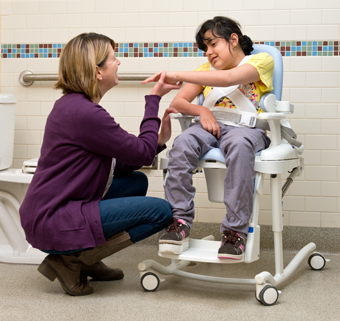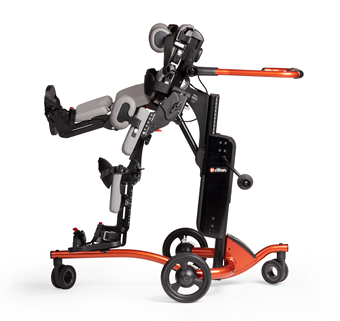Evidence Update
Rehabilitation Gait Training with Body Weight Support
| June 2017Gait rehabilitation uses both body weight supported treadmill training and over-ground training to help a client reach their maximum walking potential. With no established clinical indications, choosing between the approaches is a research-based and experience-based decision which factors in the nature of a client’s injury, timing and scope of intervention and projected outcomes. Here are two recent additions to the wealth of literature that give new insights in the field of gait rehabilitation as well as confirmation for existing practice recommendations.
Study 1: Intervention Dosing and Method for Best Gait Outcomes

This study compared four body-weight supported locomotor training approaches in a population of individuals with chronic motor-incomplete spinal cord injury (SCI) while looking for relationships between dosing parameters and functional outcomes. Specifically, how distance-dose (distance walked across all sessions) and time-dose (time spent in walking across all sessions) affect overall walking distance and walking speed within each intervention.
Sixty-four participants at least one year post SCI trained in one of the four locomotor groups:
1. Treadmill with manual assistance for stepping (TM)
2. Treadmill with electrical stimulation (TS)
3. Over-ground with functional electrical stimulation (OG)
4. Treadmill with robotic gait orthosis - 100% guidance force (LR)
After baseline measurements, the 60 minute training sessions happened 5 days/week for 12 weeks.
Distance-dose Results
For the over-ground group, greater walking distance correlated with greater improvements in both distance and speed-related outcomes. There was no significant correlation for the treadmill groups.
Time-dose Results
Increasing walking time did not significantly influence walking speed or distance across all four groups.
Interesting Observations
The robotic treadmill group achieved a distance-dose and time-dose considerably greater than the other three approaches (distance: 10x more than TM and TS and 5x more than OG) (time: 5-6x more than TM and TS and 2x more than OG), but made the least functional improvements. This may be explained by the total guidance of the robotics, which leaves little room for active effort on the part of the client, a key aspect in motor learning and functional gains.
The over-ground group achieved the second largest distance-dose and time-dose, and improved in distance outcomes. Comparing this to the robotic treadmill group suggests that it is not the length of time spent in training, but rather how an individual engages in the activity that produces the results. Or, that a greater number of step repetitions produces greater functional change in walking ability, but only when transferring the skill to a natural walking environment.
Reference
Sandler EB, Roach KE, Field-Fote EC. Dose-response outcomes associated with different forms of locomotor training in persons with chronic motor-incomplete spinal cord injury. J Neurotrauma. 2017;34(10):1903-08.
Study 2: The Use of Body-Weight Support in Gait
This study compared the effects of body-weight support (BWS) with walking over a treadmill to walking over-ground for individuals with chronic stroke. The twenty-eight participants were all more than 6 months post-stroke, and walking with hemiparetic gait. Both groups performed eighteen gait training sessions.
The amount of BWS during training sessions ranged from 30% to 0%, depending on the alignment of trunk and limbs and proper weight shift and weight bearing onto the hemiplegic limb. The participants progressed by reducing BWS, increasing gait speed, and/or reducing handhold support.
The outcome measures were gait speed, endurance, motor functional independence, and gait parameters including step length, step symmetry ratio, and single-limb support on the affected limb. Measurements were taken at baseline, at 1 week after the last gait training session and at 6 weeks after gait training.
Gait Speed Results
Both groups increased their speed after the intervention and at follow-up (using the 10-meter walk test). Because gait speed is a measure of walking ability and functional independence, the authors suggest exercising clinical judgment when choosing between treadmill training and over-ground gait training to improve gait speed.
Endurance Results
Both groups demonstrated improvements in endurance using the 6-minute walk test (6MWT). The 50 meter improvements seen in this study exceed the 34.4 meter improvement suggested by previous studies to be the “minimal clinically important difference for individuals with stroke.” So if the goal is to improve endurance during gait, BWS both over-ground or over a treadmill would be an appropriate intervention.
Additional improvements seen by both groups were recovery of lower limb motor function impairments, functional independence, nonparetic step length and single limb support duration for the paretic limb.
Step-Length Symmetry Ratio
Interestingly enough, step-length symmetry ratio improved only in the over-ground gait group. This is an important finding for a few reasons.
- Reduced step length symmetry ratio has been found to increase fall risk. So improving step length symmetry through over-ground gait training has the potential to decrease fall risk.
- As individuals with stroke often desire to look more “normal,” improving gait symmetry through over-ground practice contributes to that goal.
- Improved symmetry in gait may also reduce the energy cost of walking through less demanding gait patterns and completion of ADLs
Walking on a treadmill will also increase step symmetry to a certain extent, but other studies show this does not carry over well to over-ground walking. The active motor requirements in over-ground walking appear to be an important factor for promoting spatial symmetry in gait.
This study supports the use of BWS both over a treadmill and over-ground in the rehabilitation of people with chronic stroke, but if a BWS is available for over-ground walking, the authors suggest it may be more useful than a treadmill.
Reference
Gama GL, Celestino ML, Barela JA, Forrester L, Whitall J, Barela AM. Effects of gait training with body weight support on a treadmill versus overground in individuals with stroke. Arch Phys Med Rehabil. 2017;98(4):738-45.





